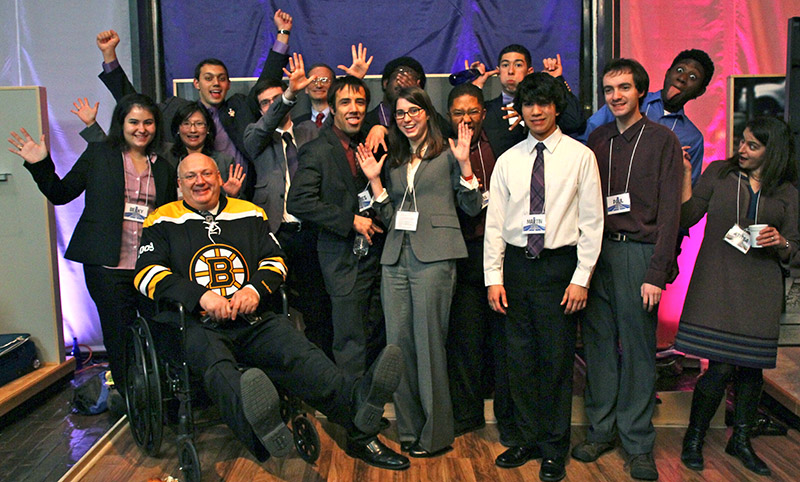

2.009 is a class taken during the senior fall semester where students work in large teams (my team had 11 people) to design and build a product that you could buy off the shelf. Our product was Ascent, a motor-assisted manual wheelchair. This product is intended for new wheelchair users that grow fatigued from long days, steep ramps, and inclement weather.
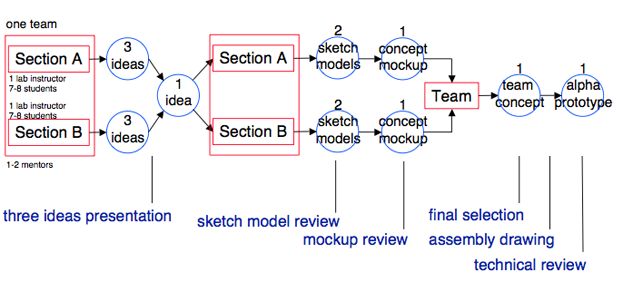
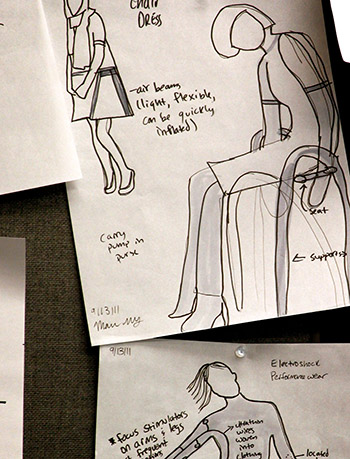 The first task in creating a new product to come up with ideas. It is important to come up with several ideas at the beginning and narrow it down to one. The group is quite large (~12 people), so you have to come up with an idea that everyone feels comfortable with (i.e. an idea that everyone is knowledgeble about). The idea also has to be innovative, not inventive. You only have a semester to make this product, so you can't bite off more than you can chew. You have to combine known parts in a new way, not come up with something entirely different. It also has to be something that people will buy. It has to be something that makes people say "Wow!" just from the title. As you can see, brainstorming is pretty important for product design. It is so important, that for 2.009 we spend half of the semester doing it. People are surprised when we say that a team of people made a product in a semester, but actually, we make a product in half a semester. In our case, as you will see, we really made the product in about 2 weeks, not because of procrastination, but because of so many failed designs.
The first task in creating a new product to come up with ideas. It is important to come up with several ideas at the beginning and narrow it down to one. The group is quite large (~12 people), so you have to come up with an idea that everyone feels comfortable with (i.e. an idea that everyone is knowledgeble about). The idea also has to be innovative, not inventive. You only have a semester to make this product, so you can't bite off more than you can chew. You have to combine known parts in a new way, not come up with something entirely different. It also has to be something that people will buy. It has to be something that makes people say "Wow!" just from the title. As you can see, brainstorming is pretty important for product design. It is so important, that for 2.009 we spend half of the semester doing it. People are surprised when we say that a team of people made a product in a semester, but actually, we make a product in half a semester. In our case, as you will see, we really made the product in about 2 weeks, not because of procrastination, but because of so many failed designs.
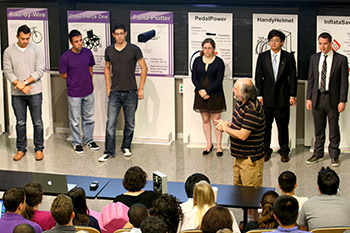 In the 3 ideas presentation, we narrow down the ideas that we brainstorm in our subgroups to three that we present to the class via posters. I'm not sure why, but I remember working on it at the last minute. I remember that the big criterion that narrowed down our ideas was originality. We came up with a bunch of really cool ideas on our own, only to find out that they already existed. Even the ideas that we presented weren't entirely original, we just presented them as unique adaptations with new features, etc.
In the 3 ideas presentation, we narrow down the ideas that we brainstorm in our subgroups to three that we present to the class via posters. I'm not sure why, but I remember working on it at the last minute. I remember that the big criterion that narrowed down our ideas was originality. We came up with a bunch of really cool ideas on our own, only to find out that they already existed. Even the ideas that we presented weren't entirely original, we just presented them as unique adaptations with new features, etc.
 A sketch model is a model that is meant to identify a key issue in a product. This issue is one that will strongly influence the idea selection process; it could make or break the idea. It is not a fully functional prototype, it is a model that is only sufficient for testing an idea.
A sketch model is a model that is meant to identify a key issue in a product. This issue is one that will strongly influence the idea selection process; it could make or break the idea. It is not a fully functional prototype, it is a model that is only sufficient for testing an idea.
For Purple B, the two ideas that we tested were Chair Force One and the Porta-Plotter. I was on the Chair Force One group, and the idea that we wanted to test was the force sensing. The force sensing is actually one of the hardest parts of the project, and the solution we implemented for the sketch model ended up being adapted for the final product. For force sensing we used strain gauges on the beams that connect the hand rim to the wheel. Dr. Barbara Hughey helped us tremendously by giving us strain gauges, helping us set up our wheatstone bridge and helping us set up Logger Pro to collect data.
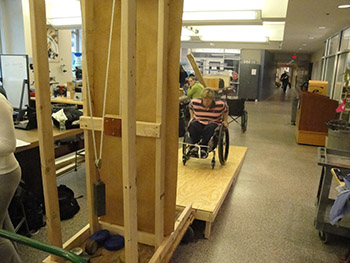 The mockup is a model of the overall structure of the product. Again, there should be a key issue identified and addressed. Our key issue was to find out how much boost should be added by the motor and how that should be implemented. To test how much boost should be added, we made an ADA compliant ramp and rigged a pulley system with weights attached to a wheelchair to see how changing the assist level changed the effort needed to help the user up the ramp. We had testimony from a wheelchair user and we tested the pulley system on another wheelchair user.
The mockup is a model of the overall structure of the product. Again, there should be a key issue identified and addressed. Our key issue was to find out how much boost should be added by the motor and how that should be implemented. To test how much boost should be added, we made an ADA compliant ramp and rigged a pulley system with weights attached to a wheelchair to see how changing the assist level changed the effort needed to help the user up the ramp. We had testimony from a wheelchair user and we tested the pulley system on another wheelchair user.
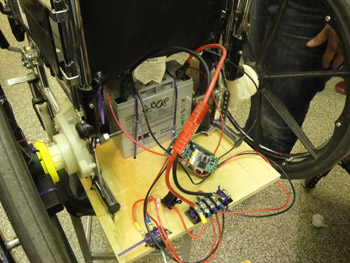 Meanwhile, we implemented a motor and gearbox assembly on another wheelchair. On this wheelchair, we actually used Fischer-Price motors and gearboxes. We 3D printed a coupling to couple the output of each gearbox to each of the wheels. We also added electronics and a huge lead-acid battery. We didn't finish force sensing in time, but that wasn't what mattered. The mockup review is all about a proof of concept. In the Sketch Model Review, we proved that strain gauges are viable for force sensing, and in the Mockup Review, we showed that we can provide assistance and we figured out how much assistance we needed.
Meanwhile, we implemented a motor and gearbox assembly on another wheelchair. On this wheelchair, we actually used Fischer-Price motors and gearboxes. We 3D printed a coupling to couple the output of each gearbox to each of the wheels. We also added electronics and a huge lead-acid battery. We didn't finish force sensing in time, but that wasn't what mattered. The mockup review is all about a proof of concept. In the Sketch Model Review, we proved that strain gauges are viable for force sensing, and in the Mockup Review, we showed that we can provide assistance and we figured out how much assistance we needed.
For the final idea selection, purple team was divided between choosing the Forget-Me-Not or Chair Force One. The Forget-Me-Not was easy to implement, it had a lot of potential, and the focus would be about the user experience rather than the technical aspects. Then again, the Forget-Me-Not was kind of lame. It doesn't do much, and it's hard to sell. On the other hand, Chair Force One is highly technical, involving aspects of Mechanical Engineering (it has to be mechanically robust to withstand prolonged use), Electrical Engineering (it has to be electrically robust to be safe), and Computer Science (the controller needs to be robust for a comfortable user experience.) It also had several unknowns: How will force sensing work? How will the motors work? When will we have time to test it? How do we make it look pretty? Eventually, through several arbitrary processes and a 6 to 4 vote, Chair Force One prevailed.
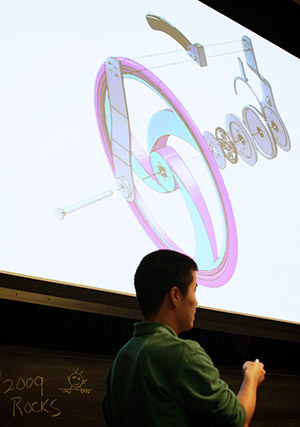 Assembly Review is a review of the CAD model of the product. In the assembly review, the goal is to refine the vision of the product. This is where the group moves from high-level decisions like how are we actuating this product to nitty-gritty details like how the motors are attached and how they should fit together. For us, we decided to make our own gearbox and the rest of the CAD was kind of rough. We imported a CAD model of a wheelchair and we also imported a CAD model of a Fisher-Price motor. The motor mount wasn't completely fleshed out, and neither was the battery box assembly. Then again, not all of the issues had to be completely fixed in the CAD model. This presentation was designed more to show what direction the group was headed in so that technical experts can help. We addressed how the product was actually going to be implemented, what kind of motors and sensors we're going to use, etc. and the lab instructors review our progress and offer suggestions. We presented some nice renderings of our design, but we still had a long way to go before we had a final product.
Assembly Review is a review of the CAD model of the product. In the assembly review, the goal is to refine the vision of the product. This is where the group moves from high-level decisions like how are we actuating this product to nitty-gritty details like how the motors are attached and how they should fit together. For us, we decided to make our own gearbox and the rest of the CAD was kind of rough. We imported a CAD model of a wheelchair and we also imported a CAD model of a Fisher-Price motor. The motor mount wasn't completely fleshed out, and neither was the battery box assembly. Then again, not all of the issues had to be completely fixed in the CAD model. This presentation was designed more to show what direction the group was headed in so that technical experts can help. We addressed how the product was actually going to be implemented, what kind of motors and sensors we're going to use, etc. and the lab instructors review our progress and offer suggestions. We presented some nice renderings of our design, but we still had a long way to go before we had a final product.
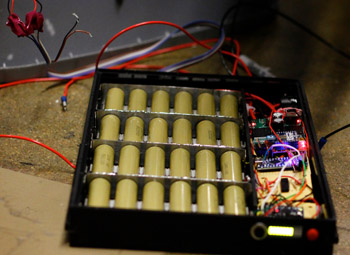 Tech Review is where you make a functional prototype of the product. This does not have to look like a finished product, but it has to work like one. This review is where Purple Team struggled the most. We had so many technical challenges in force sensing, motor mount design, batteries, clutches, and integrating it all with a wheelchair. Thanks to Tom, the batteries and on-board controller was a success, but every other aspect was subpar to say the least. Force sensing didn't work after several versions of 3D printed parts, we ended up not using any of them. Clutches came in on the Saturday before the Tech Review on Monday, so we just slapped together a motor mount design since we didn't have time to properly design one. Overall, it was a mess; it wasn't even close to a final product. We did learn a lot though and we came up with several ideas that we implemented in the final product.
Tech Review is where you make a functional prototype of the product. This does not have to look like a finished product, but it has to work like one. This review is where Purple Team struggled the most. We had so many technical challenges in force sensing, motor mount design, batteries, clutches, and integrating it all with a wheelchair. Thanks to Tom, the batteries and on-board controller was a success, but every other aspect was subpar to say the least. Force sensing didn't work after several versions of 3D printed parts, we ended up not using any of them. Clutches came in on the Saturday before the Tech Review on Monday, so we just slapped together a motor mount design since we didn't have time to properly design one. Overall, it was a mess; it wasn't even close to a final product. We did learn a lot though and we came up with several ideas that we implemented in the final product.
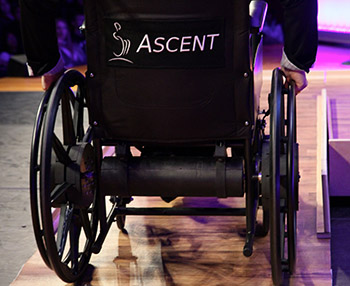 For the final product, we scrapped most of what we had for Tech Review and went for a complete redesign. This is where I was in lab ALL OF THE TIME. There was a lot of design work and machining to be done and a limited time to do it. In that amount of time, I made a motor mount and the steel, keyed drive shafts that connected the clutch to the wheel. I also helped out with force sensing, but in the interest of time, we just ended up using strain gauges. The motor mount (and the product as a whole) design was really ad hoc, unlike my other designs which are carefully planned.
For the final product, we scrapped most of what we had for Tech Review and went for a complete redesign. This is where I was in lab ALL OF THE TIME. There was a lot of design work and machining to be done and a limited time to do it. In that amount of time, I made a motor mount and the steel, keyed drive shafts that connected the clutch to the wheel. I also helped out with force sensing, but in the interest of time, we just ended up using strain gauges. The motor mount (and the product as a whole) design was really ad hoc, unlike my other designs which are carefully planned.
Overall, the project was perhaps too ambitious for this course. The project was technically complex, which made it really hard to meet deadlines. As such, we just slapped stuff together without doing a lot of CAD, FEA, or calculations. It was mostly sketches and machining. I learned that this is not necessarily a bad design method, just a different one. Some product lend themselves to this design method. For instance if I were to design a cell phone, there's no way that I would be able to calculate the optimal surface contour for fitting the average human hand. I should just make a few quick sketches, make some sketch models out of foam core and hand them to a test group to find the shape. That is how I would describe the overall design process for 2.009, but it is not the most feasible for this specific project. This project required much more careful planning, with CAD models, FEA, calculations, etc. However, I did learn a lot about thinking on your feet, machining steel, creativity, and the product engineering process.